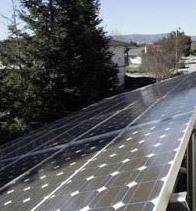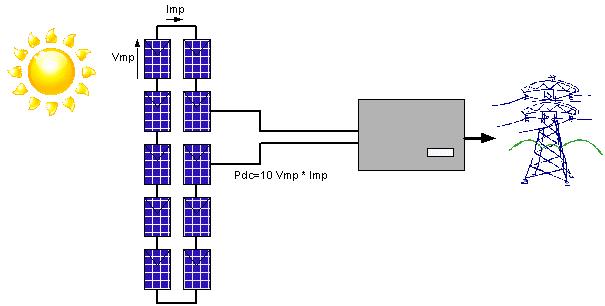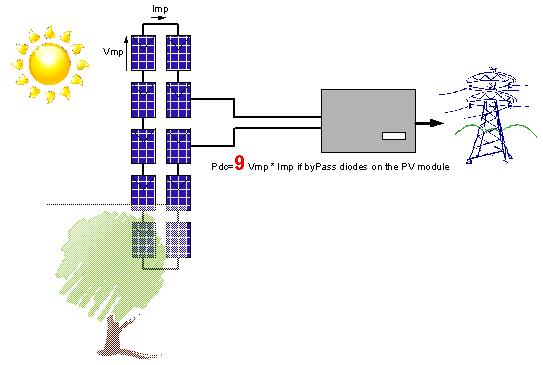I will explain here the solutions and its principle for avoiding production losses when photovoltaic systems are located in cases where there is shadow of trees, dust, chimneys, antenna, other buildings or specific relief. The idea is to install one micro inverter per Photovoltaic module to track individual Maximum Power Point. I will detail 2 design approaches with their benfits & drawbacks.
Principle: Today Photovoltaic systems are made with serial PV (PhotoVoltaic) modules to obtain a voltage in accordance with inverter input voltage. This inverter manages a global MPPT (Maximum Power Point Tracking).
This principle is well when Photovoltaic modules are very similar and when sunlight is homogeneous on the entire Photovoltaic array.
Unfortunately there are a lot of cases where a shadowing can impact a part of Photovoltaic array (tree, dust, chimneys, antenna, other buildings or specific relief).
In this case, the shadowed module curve ( I-current versus V-voltage) moves as described in the following diagram. The current decreases a lot but not the voltage.
Shadowed module has low current. To avoid impacting all the string, modules manufacturer adds bypass diodes inside the junction box and then shadowed module is bypassed.
When module is partially shaded, the current don’t switch to the diode and energy yield can be impacted with production losses up to 30% under 10% Photovoltaic shading.
See excellent article : Effects of shadow on grid connected Photovoltaic systems, N. Chantreuil, F. Barruel, X. Lepivert, H. Buttin, J. Merten, INES R.D.I., laboratory for solar Systems (L2S)
The best solution to avoid these production losses is to have distributed MPP Tracking. That means one micro inverter per Photovoltaic module to track individual Maximum Power Point. Then micro inverter s can take the maximum power of each individual module without impacting the other module and the production is fully optimized always.
There are few actors with two approaches of distributed micro inverter s.
Distributed micro inverter s actors:
- Enphase Energy technology is based on a DC/AC micro converter and each converter is connected in parallel on a common AC bus.
- GreenRay solar.
- Petra Solar with SunWave AC Module.
- Solar Bridge Technologies.
Distributed DC/DC converters with centralized inverter actors:
- eIQ energy : bases on DC/DC micro converter with a independent voltage output and can be used with standard inveter.
- SolarEdge : based on DC/DC micro converter with a dedicated central inverter without the entry stage ( boost and mppt)
And new actors arrive on this market but the products aren’t still ready and the website:
- Enecsys
- SolarMagic by National Semiconductor (Act Solar)
- Tigo Energy with Module Maximizer
At least, research departments are looking on this technology:
- Solution Photovoltaic : a consortium of 8 research centres, universities and industrials with French government funds is working on it too.
Both approaches fix the partial Photovoltaic shading issue.
My preference is for distributed DC/DC converter associated to a centralized inverter because :
- it’s easier and more safety to manage one grid connection point. All specific requirements for grid connection are very strong (VDE 126-1-1, RD1663, DK5940) and the multiplication of the deconnection devices increase the failure rate.
- there devices are subject to extreme temperature because of roof installation and this approach is minimizing the electronic parts and allow to increase the failure rate .
Pro’s & Con’s
Benefits of these distributed micro inverter architecture are:
- Improve energy harvest in case of partial Photovoltaic shading
- Cancel module mismatch impact: Each module is independent and module ranking isn’t necessary.
- Improve the safety: the DC voltage may be switch off at the module level versus a string where dangerous high DC voltage is done during all the day. (Arc detection is sometime promoted by manufacturer too)
- Allow supervision up to the module: if micro-converters have communication board embedded, it’s easy to have high level of supervision
Drawbacks are:
- Higher price per Watt than a centralized converter. This solution costs 5% more than a centralized inverter (and conversion share is twice).
- Lower efficiency than a centralized inverter. We consider efficiency around 95 – 96 % for global converter versus 97 – 98 % with a centralized inverter.
Also why using distributed solution? Higher price (+5%) and lower efficiency (-3%) are the opposite than the customer want: have the smallest ROI!
But when Photovoltaic array is not installed in optimum situation as shadow not removable (chimney, lift machinery, air cooling systems …) the micro inverter technology balance higher price and lower efficiency regards improve energy harvest.
To summarize
This technology is very interesting when Photovoltaic systems are installed on urban roof where Photovoltaic shading constraints are not removable or where multi orientations are required by building architecture. It isn’t required for solar farm where Photovoltaic shading can be cancelled and modules orientation is optimized.
Different market surveys consider than this disruptive solution will take between 2% to 10% of the solar market in the next 3 years. It will be a success story for disruptive innovation!
Yves Jeanjean




Hi ,
I found your website perfect for my needs. It contains wonderful and helpful posts. I have read most of them and it was informative for all.
Your blog is excellent and very informative to our visitors. Post was very nicely written and it contains useful facts. I am happy to find your distinguished way of writing the post.
Why diode is connect with PV module
Why diode is connect with PV module and how it will connect.IS it will improve the efficiecy of solar system if yes then How
The PV cells (5′ or 6′) are connected in serial inside a module and the modules are also connected in serial to obtain a string. If a cell is shading:
• Without bypass diode, you will limit the current for all the string and the yield harvest will divide by 10 or in the worst scenario, the cell becomes a receptor, heats up to a hot spot and destroys itself. In this case, you open the serial line and the PV production stop.
• With bypass diode, you will bypass the group where the cell is shading (i.e. 18 cells) and protect the rest of the string. You slash a small part of your string to preserve the rest of your yield harvest.
It’s wrong to say the bypass diode improves the efficiency, but we can say that the bypass diode optimizes the possible yield harvest in case of partial shadow or fault on the string.
Guys,
Anybody has a design guide for PV systems, from A to Z.
If anybody can send me some useful documentation: mrdiko@hotmail.com
Regards.
I would think that no well-designed PV system is designet with only one large inverter, as described here. Everyone whos involved in designing systems like this, know that one have to take account of shadows, by installing several smaller inverters. One inverter per module seem expensive.
Hello Erlend,
do you any contracting particular experience in installing that type of PV system ? or your comment refers to design know how?
thanks to to tell us
Can you help me set-up a small PV unit on my roof that can give me 650Watts or 150 VA power.
what sort of help you exactly need?
We do photovoltaic system
Best regards,
can u help me set -up for a small unit on my roof that can give 1kw or 500w
If I have an solar unit, how I shall get electricity with that, does it need more aparatus? Batery,circuit or any interter? Could you please help me to set up one unit?
how about block diode in PV .mine is damage how to do that?please tell me that u know .thanks!